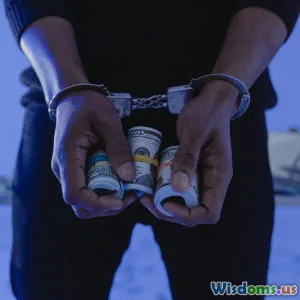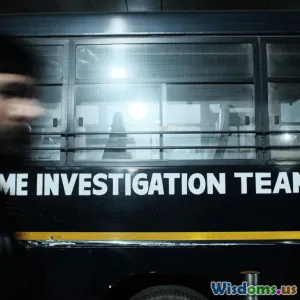
Inside the Joint Ops That Brought Down Major Drug Rings
13 min read Explore how coordinated global joint operations dismantled powerful drug rings, revealing strategy, technology, and international cooperation behind history’s biggest narcotics takedowns. (0 Reviews)
Inside the Joint Ops That Brought Down Major Drug Rings
Introduction: Puzzle Pieces in the Fight Against Narco Empires
Picture a shadowy warehouse in an unassuming city suburb. Dozens of law enforcement officers move in sync, eyes on their targets. Thousands of miles away, another team, armed with intelligence, executes a simultaneous raid. Within hours, a sprawling criminal network is shorn of leadership, its assets seized, and its future cast into doubt.
Behind such seismic drug busts are meticulously planned joint operations—strategic, often international alliances formed by police forces, intelligence services, customs, and sometimes even military units. These collaborations are more than shows of force. They're high-stakes puzzles, reliant on trust, technological savvy, human intelligence, and relentless dedication. This article sheds light on how joint operations have defeated some of the world's most notorious drug organizations, transforming the law enforcement playbook along the way.
Behind the Curtain: How Joint Operations Function
What Are Joint Operations?
A joint operation isn’t just agencies working side by side—it's a synchronized initiative blending resources, legal powers, and specialized skills. They may involve local police, federal agencies (such as the DEA, FBI, Customs and Border Protection), overseas partners like INTERPOL or Europol, and even armed forces.
The reason for such broad collaboration? Drug trafficking across borders is a global business. In 2022, the UN Office on Drugs and Crime (UNODC) estimated the illicit drug market was worth upwards of $450 billion yearly. Traffickers exploit legal loopholes, language barriers, and jurisdiction gaps. Only a seamless, multi-jurisdictional counterstrategy can close off escape routes.
Core Components: Layers of a Successful Joint Operation
-
Intelligence Gathering: The backbone of any joint op. Agencies pool information: suspect movements, bank records, communications data, etc. Modern surveillance tools—cellphone data extraction, drones, and even satellite imagery—provide actionable insight.
-
Coordination & Planning: Frequent cross-agency briefings, encrypted communication, and shared command structures. Operations may require months—or years—of planning.
-
Simultaneous Action: Highly trained teams orchestrate arrests and seizures at multiple points, often across countries or continents.
-
Legal Complexity: Navigating extradition, international law, and differing prosecution standards can make or break the mission. Some busts need direct coop from local governments or special bilateral treaties.
As former DEA Agent John Hummel described: “It’s like trying to hit a single moving target while running a relay race. Every runner has to know exactly when to grab the baton.”
Landmark Joint Operations: Turning the Tide
Breaking the Medellín Cartel – Operation Search Bloc
No account of anti-drug ops is complete without Colombia’s efforts against Pablo Escobar's Medellín Cartel. “Operation Search Bloc” (late 1980s–1993) brought together Colombian National Police, the CIA, and the DEA.
-
Collaboration: Colombian police led raids while US agencies provided technology—advanced wiretaps, airborne surveillance, and signal intercept squads.
-
Success Factors: Persistent pursuit, effective pressure on cartel finances, use of informants, and Colombian-US trust-building. Agents worked from secure compounds (“bunkers”), shared intelligence daily, and fought through corruption and intimidation.
-
Result: Escobar killed during a joint operation in 1993. Kathryn Ledebur, a Bolivian drug policy expert, said: “That cooperation marked a global pivot on defeating drug kingpins—proving even the most untouchable criminal networks could fall.”
EUROPOL and FBI vs. Dark Web Drug Markets: Operation Disruptor (2020)
The internet changed trafficking forever, but so did law enforcement collaboration. In 2020, “Operation Disruptor” targeted users of dark net narcotics sites like Wall Street Market and AlphaBay.
-
Collaboration: The FBI, Europol, DEA, and over half a dozen EU countries synced intelligence. Cyber-forensics teams built profiles using crypto tracing, malware, and buyer-seller “sting” buys.
-
Tactics: Seized servers, posed as market admins, tracked package origins, and arrested 179 key traffickers. Law enforcement used data logs to prosecute high-volume dealers in multiple nations.
-
Aftermath: Seizure of over $6.5 million in crypto, plus guns and large quantities of synthetic opioids such as fentanyl. Europol chief Catherine De Bolle said, “We proved criminal online anonymity is a myth. If you sell pain, we will find you.”
Mexican Navy, DEA, and Interpol – El Chapo’s Capture
Joaquín “El Chapo” Guzmán, head of the Sinaloa cartel, was infamous for escaping from high-security prisons. But on January 8, 2016, that changed.
-
Intelligence Nexus: The DEA shared intercepted phone traffic and tracked smartphone metadata. Mexico's Secret Service (SEIDO) used this data to triangulate El Chapo’s location—culminating in a dawn raid in Los Mochis, Sinaloa.
-
Coordination: Real-time, bilingual communications; teams on the ground and in U.S. command centers; Interpol alerts at airports post-arrest ensured no escape.
-
Outcome: El Chapo extradited to the US, ending a 15-year manhunt that involved every major law enforcement player in North America.
The Technology Revolution: Tools Empowering Joint Ops
Data Fusion Centers and AI Surveillance
Prior to 2010, cross-border agencies relied on phone calls or dispatch faxes—slowing decision cycles. Enter data fusion centers: secure hubs where agencies upload, analyze, and flag shared intelligence in real time.
Advanced artificial intelligence (AI) models now scan financial data, phone metadata, and social media at superhuman speeds to detect trafficking “signatures.” For instance, during Operation Trojan Shield (2021), the FBI set up a fake encrypted phone network (ANOM) that 12,000 criminals used—then harvested terabytes of conversations, leading to 800+ arrests globally.
Aerial and Digital Surveillance
Unmanned Aerial Vehicles (UAVs, or drones) have changed game—in 2021, Customs and Border Protection UAVs tracked smuggling boats for miles until law enforcement units moved in synchrony for arrests.
Facial recognition at borders and smart container tracking help coordinate multi-nation port busts. In Operation IRINI (2020; EU naval taskforce), real-time satellite data allowed teams to track suspect cargo ships from Africa to Europe.
Crypto Tracing
As traffickers moved to cryptocurrencies, so too did investigators. Blockchain analysis tools like Chainalysis and Elliptic are used jointly by agencies—turning “untraceable” transactions into leads, asset seizures, and court evidence.
International Alliances: The Rise of Global Anti-Narcotics Taskforces
The United Nations and INTERPOL
Through platforms like the UNODC’s “Container Control Programme” and INTERPOL’s “Operation Lionfish,” over 100 countries now synchronize maritime and airport inspections, share watch lists, and jointly analyze trends. Joint taskforces share expertise—such as Colombian commando support to West African units or FBI cyber labs mentoring Eastern European teams.
Notable Multi-National Efforts
- Operation Lionfish (INTERPOL): In 2013, over 30 countries across Latin America and West Africa coordinated to seize 132 tons of drugs in 2 weeks, along with $36 million in assets.
- Operation Thunderbolt (Asia–Oceania, 2019): Partnered military, customs, and police across 17 Pacific nations to smash both meth superlabs and trafficking pipelines.
These coalitions provide “force multiplier” effects, as officers share best practices and synchronize disruption efforts to dismantle entire supply networks.
The Human Element: Trust, Training, and the Price of Success
Even as technology evolved, the success of joint ops still rests on human factors:
-
Trust & Cultural Awareness: Officers from different countries and agencies often have distinct work styles, languages, and bureaucratic traditions. Building rapport—often through joint training or exchange programs—proves crucial.
-
Embedded Agents and Linguists: Multi-lingual operatives and embedded liaison officers bridge language barriers, help navigate foreign legal systems, and prevent misunderstanding.
-
Risk and Sacrifice: Many top operatives work undercover, facing significant personal risk. In Colombia alone, more than 3,000 officers lost their lives fighting the Escobar cartels; globally, deep-cover agents face retaliation threats each year.
Nick Anderson, a retired Interpol liaison, remarks, “You don’t catch kingpins from behind a desk. You do it in the field. And in the field, trust is the only real currency.”
Obstacles and Lessons Learned
-
Legal ‘Safe Havens’: Some countries restrict extradition for drug crimes, while others limit data sharing. Joint ops must invent “workarounds”: third-country arrests, intelligence swaps instead of evidence transfers, and synchronized diplomatic pressure.
-
Resource Gaps: Less wealthy partners may lack technical tools or forensic labs. Operations increasingly include tech donations, equipment sharing, and training grants as part of the alliance.
-
Sustainability: Critics note that joint ops can lop off kingpins but sometimes spark power vacuums or “balloon effects” as remaining cartels scatter or re-form. Forward-thinking taskforces now focus on concurrently strengthening local justice systems and economic alternatives for at-risk communities.
Conclusion: The New Blueprint for Global Crimefighting
Today’s international joint operations represent the cutting edge of anti-narcotics strategy: fusing resources, leveraging technology, and building personal alliances that transcend borders. Past victories against Escobar, El Chapo, and dark web syndicates weren’t just matters of luck or muscle; they were hard-earned breakthroughs rooted in trust, adaptability, and vision.
But the work is far from done. The ongoing evolution of drug rings—intensified by globalization, digital tech, and shifting consumer demand—means tomorrow’s joint ops will have to stay even sharper. Through each success and setback, one truth echoes: collaboration is the world’s most potent weapon against the trafficking empires threatening our societies.
Action Step for Readers: Supporting transparent, international law enforcement alliances is key, whether through advocacy, funding, or simply by demanding global accountability. The next chapter in the fight begins with awareness—and every informed citizen has a role to play.
Rate the Post
User Reviews
Other posts in Interagency Collaboration in Criminal Investigations
Popular Posts















